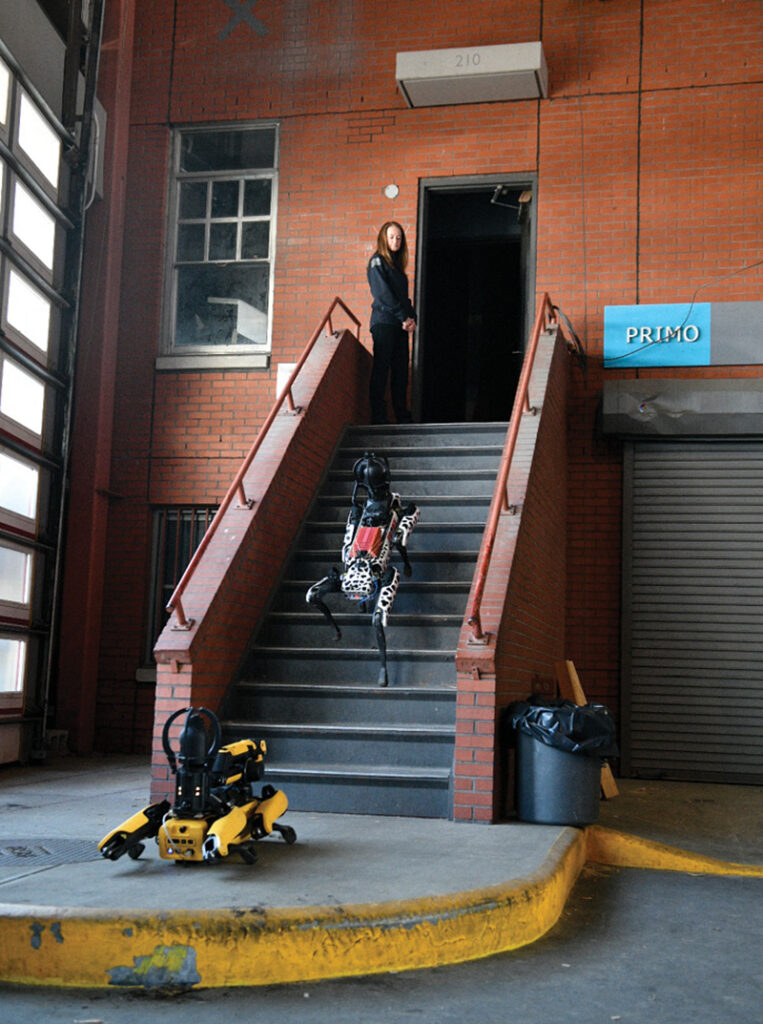
Law enforcement agencies have used ground robots for decades in hostage, barricaded fugitive, and bomb threat scenarios.
Ground robotics makers have been slow to develop robotic solutions for use by fire departments but are quietly making inroads among some departments, which are using tracked and four-legged robots in fire suppression, reconnaissance, and hazmat situations.
The Los Angeles (CA) Fire Department (LAFD) has been operating a Thermite RS3 industrial robotic firefighting vehicle made by Howe & Howe Technologies since late 2020, according to Richard Diede, LAFD captain, heavy equipment supervisor, and head of the department’s wildland fuel management unit. “Our unit typically goes to compromised commercial structure fires because the fire is so deep seated, and there’s a lot of debris over it,” Diede says. “When the RS3 is needed, we bring it out on a two-axle trailer pulled by a one-ton pickup.”
- Video Highlights Colossus Firefighting Robot Use by French Firefighters
- FDIC International 2023: Shark Robotics Exhibits Firefighting Robot Portfolio
- Intelligent Robots: Opportunities, Challenges, and Current Value in Fire and Rescue Operations
- FDNY Deploys Robot Dogs for Hazardous Search and Rescue
He notes the LAFD’s RS3 weighs 3,500 pounds and, at 5 feet 5 inches tall, 5 feet 5 inches wide, and 7 feet long, has an 8 mile-per-hour top speed. The department’s RS3 can operate on a 50% slope and a 35% slide slope and has a 36-horsepower diesel engine with a run time of 20 hours; a front plow blade to push debris, including vehicles; and an Elkhart Brass 2,500-gallon-per-minute (gpm) monitor and nozzle with a 300-foot horizontal and 150-foot vertical stream reach. “We also have a foam aerator nozzle on the RS3, a red and green lighting package that has deflectors to prevent the light from coming back at the operator, seven 2½-inch inlets at the rear of the machine, and four visual light and infrared cameras: thermal imaging and visual light cameras on the monitor turret, a center front camera that gives the operator direction heading, and a rear-facing camera,” Diede points out. “We use the RS3 mostly in defensive operations on commercial structure fires and have been assigned to 39 fires since we got it,” Diede says. “We also are able to use the RS3 in a search scenario for victims because the thermal imaging camera (TIC) will be able to pick them up.”
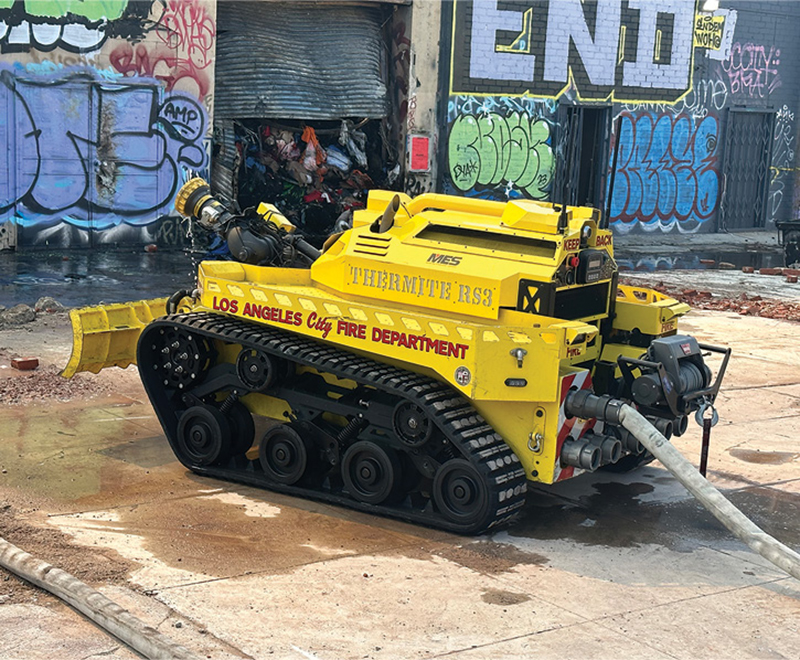
1 The LAFD has been operating a Thermite RS3 robotic firefighting vehicle customized according to the department’s specs. The unit has been assigned to 39 commercial structure fires in the past three years. (Photo 1 courtesy of the LAFD.)

2 A Howe & Howe Thermite RS3 robot built for the LAFD operates at a commercial structure fire. (Photo 2 courtesy of Howe & Howe Technologies.)

3 A Rosenbauer RM35 remote controlled firefighting tracked robot is shown prior to testing at a Roseville (MN) Fire Department station. (Photo 3 courtesy of Rosenbauer.)
Howe & Howe also makes the Thermite RS1, a smaller tracked robotic device at 77 inches long, 38 inches wide, and 64 inches high with a 700- to 1,250-gpm water stream through an Elkhart Brass Cobra monitor. The Thermite EV1 is an all-electric firefighting robot that can provide real-time situational awareness. Howe & Howe says it is powered by a dual electric drive 200-amp-hour battery system. The unit also carries an Elkhart Brass 700-gpm monitor and nozzle. The fourth ground robot in the Howe & Howe line is the larger size modular design Thermite EV2 powered by the same battery system as the EV1 but with a 1,250-gpm Elkhart Brass monitor and nozzle.
Rosenbauer recently made its RM35 remote controlled fire extinguishing tracked robot available for the North American market. Ernie Young, western regional manager for Rosenbauer America, says the RM35 recently was displayed and operated during a demonstration tour in Phoenix, Arizona, and Las Vegas, Nevada. “We have two models available, each powered by two 48-volt electric motors and four 12-volt lead-acid batteries,” Young points out. “These use the Rosenbauer RM15 and RM35 monitors, which can deliver 530 gpm and 925 gpm, respectively.”
The RM15 weighs 1,080 pounds and is 47¼ × 31½ × 33½ inches stowed, Young says, while the RM25 weighs 1,105 pounds and is 47¼ × 31½ × 35 inches stowed. Both models are controlled by a joystick with a 3½-inch color monitor display screen, have programmable spray pattern oscillation, have four-step flow rate controls, and carry a monitor heat protection sprinkler and a 4-inch Storz inlet, while the RM35 also has a 1½-inch handline outlet.
Young notes that firefighters can hook up visual light or infrared cameras to the turret of the unit, which has a remote control range of 700 feet and a video feedback range of 350 feet. “Both units can be set up without a monitor to allow the robot to carry gear and equipment and function as a mule, like at a hazmat scene,” Young observes. “The units can be loaded on a trailer or in the bed of a pickup truck, or they can be run from a rescue truck compartment with a drop-down ramp.”
The complement to firefighting tracked robots are legged robots, like the Boston Dynamics-manufactured Spot®, a fully autonomous, four-legged robot that can avoid obstacles, recovers from slips and falls, climbs stairs, and has 90 minutes of runtime. Boston Dynamics says the company has more than a thousand Spot robots in the field in 35 countries, aiding first responders in assessing dangerous situations. It cites those situations as hazardous gas detection; search and rescue; subterranean or confined space exploration; and structural assessments after fires, disaster events, and other hazards.
Spot has five stereo cameras on it to operate, including a 360-degree camera with two-way communications, a 30× optical zoom to provide a fine level of detail, a gripper camera, and an infrared thermal imaging function. Boston Dynamics notes that Spot’s payload is agnostic—a payload can be detached and another locked in at the top rear of the robot. The unit can inspect and pick up objects with a rotatable arm that has jaws on the end, can open doors, and can drag an object weighing about 50 pounds along flat ground.
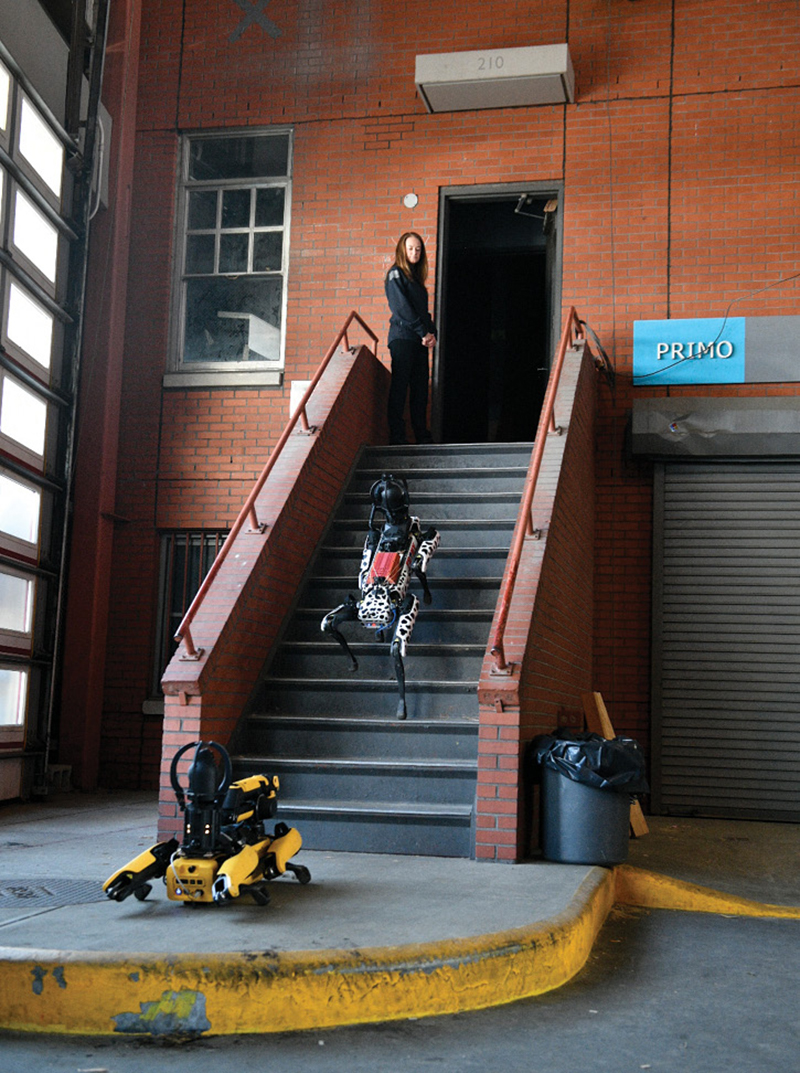
4 The Fire Department of New York (FDNY) operates two Spot four-legged robots made by Boston Dynamics, one carrying cameras and a sensor (climbing the stairs) and the other with a manipulating arm. (Photo 4 courtesy of the FDNY.)
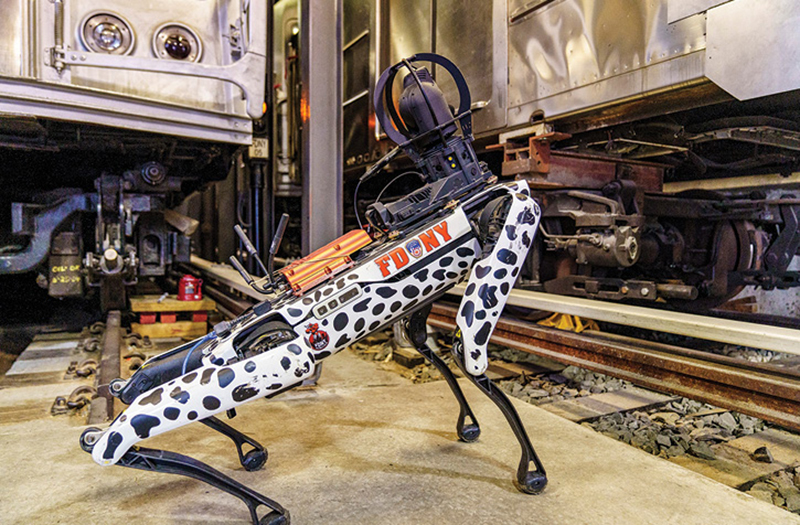
5 The Boston Robotics Spot robot built for the FDNY can carry four cameras, a microphone and speaker, and hazmat sensors. (Photo 5 courtesy of Boston Dynamics.)
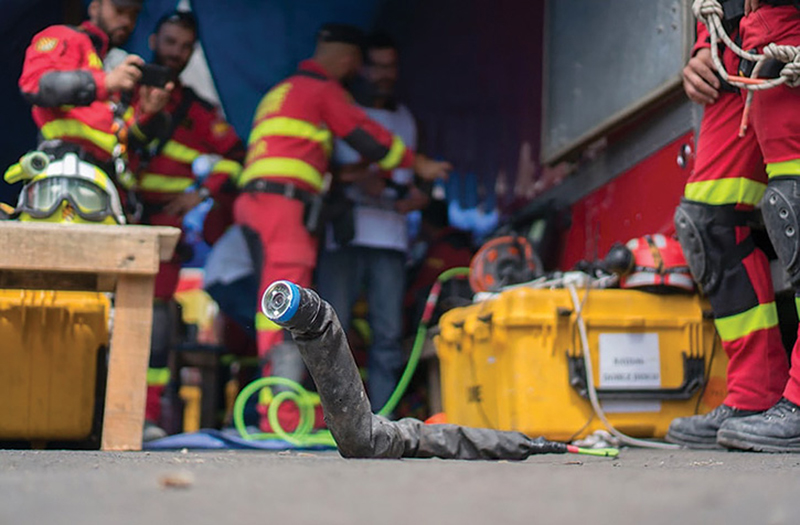
6 The snake robot, developed by a Carnegie Mellon University Robotics Institute professor, can move over rough terrain and access collapsed areas where other robotics would not be able to negotiate. (Photo 6 courtesy of Carnegie Mellon University Robotics Institute.)
Michael Leo, captain at the Fire Department of New York (FDNY) Robotics Unit, says the FDNY has two Boston Dynamics robotic units that were customized for the department. “Our robot has the ability to carry hazardous materials sensors, a microphone and speaker, a 360-degree RGB (visual light) camera, and a pan/tilt/zoom TIC,” Leo says. “Our second robot is fitted with a manipulating arm. Having one robot with sensors and one with the manipulating arm allows them to work in tandem with each other.”
Leo points out that the FDNY recently used a robot at the scene of a collapsed parking garage. “The secondary collapse meant that we didn’t want to send members or rescue dogs in, which led us to conclude that the robot was the best alternative,” he says. “Robots usually have difficulty with rubble. This specific mission allowed us to avoid most of the large rubble areas and utilize the open spaces and ramps to access areas and use the robot sensors to achieve success and collect the data needed.
In terms of tracked robots for firefighting, Leo says the FDNY has looked at some tracked vehicles and has demonstrated a Howe & Howe Thermite at the FDNY fire academy. “We also are looking at additional robots, as well as remote robotic forklift systems where we might need to move something dangerous from an area, like a fire in an electric vehicle in a parking garage,” he says. “The strategy might be removing the car from the garage to a location where it would not affect the structure or other vehicles.”
Jeb Brown, unmanned systems director for W.S. Darley & Co., says Darley is a value-added reseller for the Ghost Robotics Vision 60® Q-WGV legged robot. The unit has a dog-like profile, much like the Boston Dynamics Spot, and has command and control through a commercial radio system and 4G/5G MANET and SAT communications. Brown says that in GPS-denied areas, the robot can use breadcrumb hardware to navigate.
He adds that users can add different cameras or sensors to the robot, including multispectral cameras; infrared and TICs; and chemical, biological, radiological, and nuclear sensors. “It can be used in a search and rescue situation,” he notes. “The robot can walk on uneven terrain, can negotiate stairs, and can carry up to 25 pounds on its back. It’s transported in a Pelican case with roller wheels and weighs approximately 100 pounds.”
Howie Choset, professor of computer science at the Robotics Institute at Carnegie Mellon University, has invented a snake robot that can move over rough terrain, get into very tight spaces, and negotiate the debris of collapsed structures. “Snake robots have a narrow cross section and are relatively smooth, so they can fit into places that people and machinery can’t otherwise access in search and rescue situations,” Choset observes. “Our snake robot can perform those functions and also can be sent into containers to take back samples of dangerous materials in hazmat situations.”
Choset’s snake robot comprises 16 links, each about 2 inches in diameter and 2 inches long. The snake robot’s head holds a camera, microphone, range sensor, and LED light. “The robot is connected to the operator by a tether, so the rescue worker can look through the camera and determine which way to explore.” Choset notes that his snake robot was deployed as a search and rescue tool after a recent earthquake in Mexico. He adds that his robotics group has also developed an underwater snake robot that would be useful in inspecting the underside of ships or looking into other places where it might not be safe to send a human rescuer underwater.
ALAN M. PETRILLO is a Tucson, Arizona-based journalist, the author of three novels and five nonfiction books, and a member of the Fire Apparatus & Emergency Equipment Editorial Advisory Board. He served 22 years with the Verdoy (NY) Fire Department, including in the position of chief.

